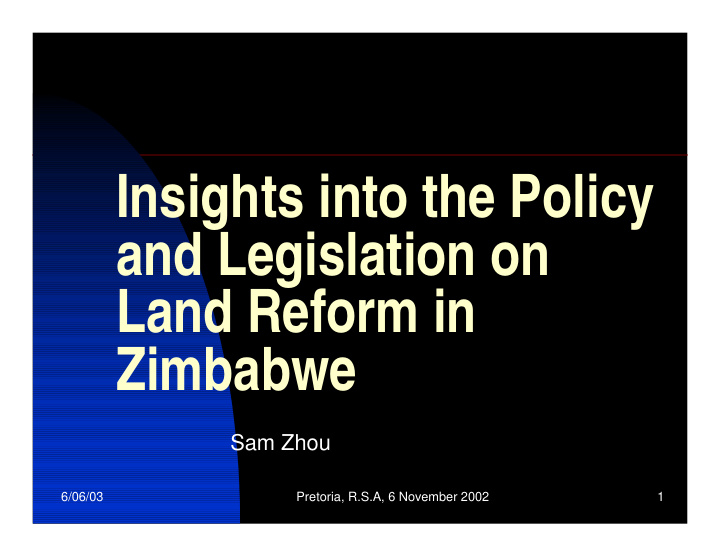



Insights into the Policy and Legislation on Land Reform in Zimbabwe Sam Zhou 6/06/03 Pretoria, R.S.A, 6 November 2002 1
Discussion Outline n Introductory statement n Summary of background issues on Land Policy and Legislation in Zimbabwe. n Some key elements of the Policies. n Implication of these policies to Professionals and requisite response. n Fast track land reform. n Concluding Remarks 6/06/03 Pretoria, R.S.A, 6 November 2002 2
Introduction “In practice, the key policy issue facing Zimbabwe’s agrarian reform policy is how to balance control and access to land, by redistributing land from large scale land holders who underutilized their land to the land poor and small scale and medium scale users, ensure security of tenure for all land holdings, and in the process engender social equity, social security and poverty reduction ………………… not only in Zimbabwe, but for the sub-region as a whole”. Hon. J. M. Made (MP), 2000, Minister of Lands, Agriculture and Rural Resettlement. Zimbabwe. 6/06/03 Pretoria, R.S.A, 6 November 2002 3
History of Land Distribution in Zimbabwe LAND CATEGORY HECTARES (MILLIONS) HECTARES (MILLIONS) At 1980 % Targets set in 1990 (2000 standing) Large Scale Commercial 15.5 39.10 5.0 Farms Small Scale Commercial 1.4 3.5 1.4 Farms Resettlement (State permit) 0 0 8.3 Communal Areas 16.4 41.4 16.4 State Farms 0.3 0.80 2.5 National Parks and Urban 6.0 15.2 6.0 Land 39.6 100 39.6 TOTAL 6/06/03 Pretoria, R.S.A, 6 November 2002 4
Size Structure of Large Scale Commercial Farms 1998 Category (ha) Farms Total Area No. % Ha % Below 400 1 314 28.2 179 136 1.6 400 – 999 1 096 23.6 748 248 6.7 1 000 – 3 999 1 736 37.2 3 344 205 29.8 4 000 – 7 999 281 6.0 1 580 744 14.1 8 000 and more 233 5.0 5 361 053 47.8 Total 4 660 100 11213386 100 Source: Moyo S. The land Acquisition Process in Zimbabwe, 1997/98 6/06/03 Pretoria, R.S.A, 6 November 2002 5
Land Policy Issues n An equitable distribution of land between racial and gender groups n Access to land for people displaced by the war and people on squatter communities on farms n Decongestion of communal areas which still hold 70% of Zimbabwe’s population n Reduction of land concentration from the hands of a few individuals to the landless majority n Extension of the cadastral register, registration and documentation of land rights beyond freehold areas 6/06/03 Pretoria, R.S.A, 6 November 2002 6
Policy issues cont n Indigenisation of the large-scale commercial farming sector n Empowering the indigenous farmers with skills, expertise and resources to take up farming as a business n Provision of basic infrastructure like roads, schools, & clinics for resettled households n Decentralisation of land administration including planning, from central government down to the village and ward levels 6/06/03 Pretoria, R.S.A, 6 November 2002 7
Land Policy! So what? n As ordinary people these policies affect our daily lives and our businesses n As professionals, our expertise drive and implement these policies n We are specially trained and equipped to design implementation strategies that may guarantee outcomes n Most professional practices have invested in training, education, equipment and other resources required in policy implementation n All of us just need political will, communication with and commitment from decision makers 6/06/03 Pretoria, R.S.A, 6 November 2002 8
Real Life Issues n Land policies imply real daily practices for Surveyors, Planners, Lawyers and Valuers n They call for boundary adjudication, registration of land and other rights and interests. n Protection of such rights and assurance that they cannot be set aside for whatever reasons n Formalization of previously informal and all squatter settlements n Preservation, protection and improvement of tenure rights, even after changes of governments 6/06/03 Pretoria, R.S.A, 6 November 2002 9
So what does this mean to us? n Search and fight for a place in decision making n Demonstrate our skills to improve decision making by providing quality information n Engage government and politicians at all levels of land administration matters n Refinement of policy planning and implementation strategies n Embrace technical aspects of land policy and avoid “them” versus “us” attitude 6/06/03 Pretoria, R.S.A, 6 November 2002 10
Fast track land reform n Started as a conceived plan meant to deliver 5 million hectares of land for LRRP2 in 4 years n Sources of land included government acquired land, designated farms and donations n No land seizure policy n The outcome has been overriding land claims and interests which will need to be documented and quantified in order to understand and sort out the problem 6/06/03 Pretoria, R.S.A, 6 November 2002 11
Conclusion n Professional people should strive to be part of policy formulation n Should be part of the design of implementation strategies that are practical, applicable and cost effective n Governments, Finance Institutions and the Donor Organisations should partner all stake-holders in the call for protection and preservation of property and tenure rights n The gap between policy, legislation and implementation should be closed, not just narrowed 6/06/03 Pretoria, R.S.A, 6 November 2002 12
Recommend
More recommend